

One of the most fundamental skills you can learn as a beekeeper is how to light your bee smoker. It is not as easy as it may seem. Really, It requires some technique and patience.
You want to be able to light it well. This will make beekeeping a more enjoyable experience for the bees and their keeper. Trust us; you will get better with practice.
The goal is to light a smoker to produce slowly burning embers in the bottom of the smoker. It will emit a “cool” smoke from the top of the smoker. If the smoke is too hot, it tends to annoy the bees and make them more defensive of the hive.
Lighting a smoker can be a real challenge. The hardest part of lighting a smoker is getting the feel (and the fuel) just right. Just think of it like Goldilocks’ porridge.
Too few embers in the bottom, and the fire will extinguish itself. Too hot, and it burns through the fuel before you are done working with your bees. You will get it just right with practice, or maybe with sheer luck. I’m sure you will.
One of the most fundamental skills you can learn as a beekeeper is how to light your bee smoker. It is not as easy as it may seem. Really, It requires some technique and patience.
You want to be able to light it well. This will make beekeeping a more enjoyable experience for the bees and their keeper. Trust us; you will get better with practice.
The goal is to light a smoker to produce slowly burning embers in the bottom of the smoker. It will emit a “cool” smoke from the top of the smoker. If the smoke is too hot, it tends to annoy the bees and make them more defensive of the hive.
Lighting a smoker can be a real challenge. The hardest part of lighting a smoker is getting the feel (and the fuel) just right. Just think of it like Goldilocks’ porridge.
Too few embers in the bottom, and the fire will extinguish itself. Too hot, and it burns through the fuel before you are done working with your bees. You will get it just right with practice, or maybe with sheer luck. I’m sure you will.
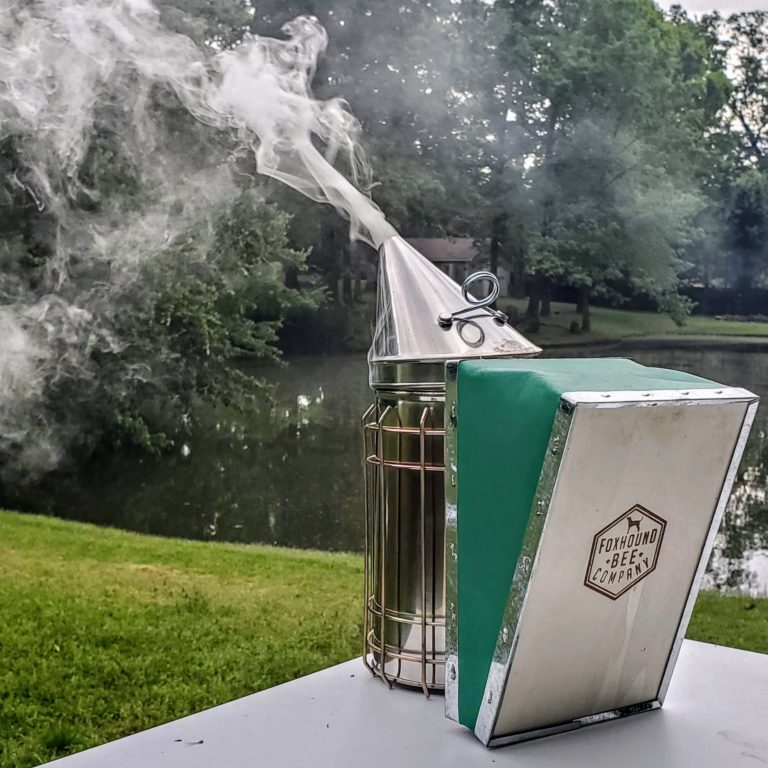
A lit bee smoker working well
Fuel For A Bee Smoker
There are different types of fuel available to light your smoker. Some are better than others, and we have used many different styles. Not every option will work well for you. There are so many options because beekeepers tend to use what is available to them and stick with it.
One beekeeper may use wood chip shavings and swear by them. This is because they may also be a woodworker and have wood shavings readily available. If you are not a woodworker, this may not be helpful to you.
You can also use raw cotton from the plant. Again, the odds of finding inexpensive natural cotton are minimal if you don’t live in the southeast.

A lit bee smoker working well
Fuel For A Bee Smoker
There are different types of fuel available to light your smoker. Some are better than others, and we have used many different styles. Not every option will work well for you. There are so many options because beekeepers tend to use what is available to them and stick with it.
One beekeeper may use wood chip shavings and swear by them. This is because they may also be a woodworker and have wood shavings readily available. If you are not a woodworker, this may not be helpful to you.
You can also use raw cotton from the plant. Again, the odds of finding inexpensive natural cotton are minimal if you don’t live in the southeast.
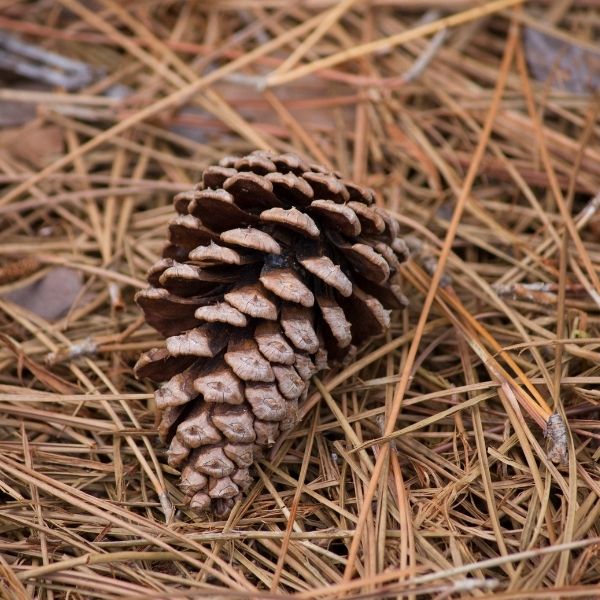
Dry pine straw works great for bee smokers
You can also go on Amazon and buy smoker pellets as an option. These may or may not work well for you. These particular types of pellets are quick burning would be good in a pinch, but shouldn’t be your number 1 choice of fuel for your bee smoker.
Before we go any further, make sure that your smoker is ready to light. All smokers come with a perforated plate inside the smoker. Sometimes it is built, so it’s ready to go, but other times you have to bend the legs, so it stands up in the bottom of your smoker. There should be a 1-inch gap or so in the bottom of your smoker where air can flow in. Look at this picture to see how the legs need to stick up.

Dry pine straw works great for bee smokers
You can also go on Amazon and buy smoker pellets as an option. These may or may not work well for you. These particular types of pellets are quick burning would be good in a pinch, but shouldn’t be your number 1 choice of fuel for your bee smoker.
Before we go any further, make sure that your smoker is ready to light. All smokers come with a perforated plate inside the smoker. Sometimes it is built, so it’s ready to go, but other times you have to bend the legs, so it stands up in the bottom of your smoker. There should be a 1-inch gap or so in the bottom of your smoker where air can flow in. Look at this picture to see how the legs need to stick up.
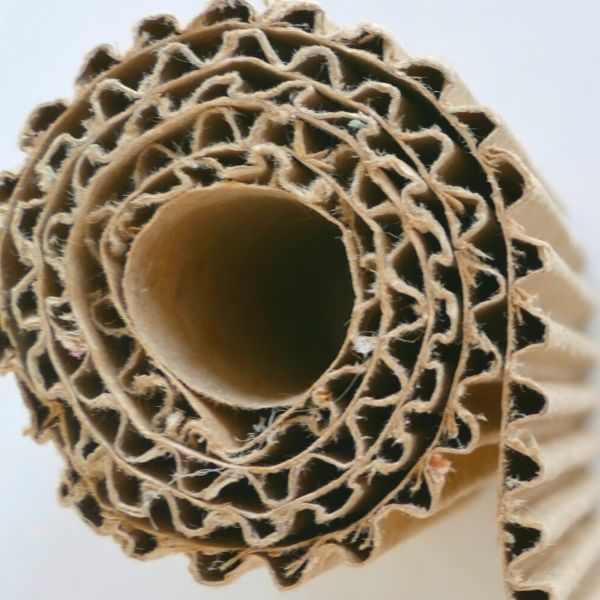
Rolled up cardboard for use in bee smoker
Pine Straw And Cardboard For A Smoker
For this lesson, we will focus on two options for fuel. They are readily available in most places for free. These are pine straw and cardboard.
Pine straw should be easy to find because pine trees are seemingly everywhere. I have even resorted to “borrowing” some of the pine straw used for landscaping on short notice. Only with the complete permission of the owner, of course. Am I right?
What about Cardboard? Well, it’s everywhere too. Pine straw is our #1 choice for fuel, but cardboard is a great backup.
Pine straw is nearly unusable when damp, but I can typically find dry cardboard on short notice.
Just a quick note on actually lighting the smoker. You need a good heat source for getting the fuel started. Obviously, you can use a lighter or a stick lighter for getting smokers going, but it’s very frustrating when they get wet or run out of fuel.
Our preferred way to light a smoker is with one of these butane torches with a click lighter. The tanks aren’t expensive, but the head for it with the clicker is the expensive part. But you only have to buy it once. They are a little big, but they last a very long time and work every single dang time. You’ll find yourself using these all over the house, so you’ll enjoy having one around.

Rolled up cardboard for use in bee smoker
Pine Straw And Cardboard For A Smoker
For this lesson, we will focus on two options for fuel. They are readily available in most places for free. These are pine straw and cardboard.
Pine straw should be easy to find because pine trees are seemingly everywhere. I have even resorted to “borrowing” some of the pine straw used for landscaping on short notice. Only with the complete permission of the owner, of course. Am I right?
What about Cardboard? Well, it’s everywhere too. Pine straw is our #1 choice for fuel, but cardboard is a great backup.
Pine straw is nearly unusable when damp, but I can typically find dry cardboard on short notice.
Just a quick note on actually lighting the smoker. You need a good heat source for getting the fuel started. Obviously, you can use a lighter or a stick lighter for getting smokers going, but it’s very frustrating when they get wet or run out of fuel.
Our preferred way to light a smoker is with one of these butane torches with a click lighter. The tanks aren’t expensive, but the head for it with the clicker is the expensive part. But you only have to buy it once. They are a little big, but they last a very long time and work every single dang time. You’ll find yourself using these all over the house, so you’ll enjoy having one around.
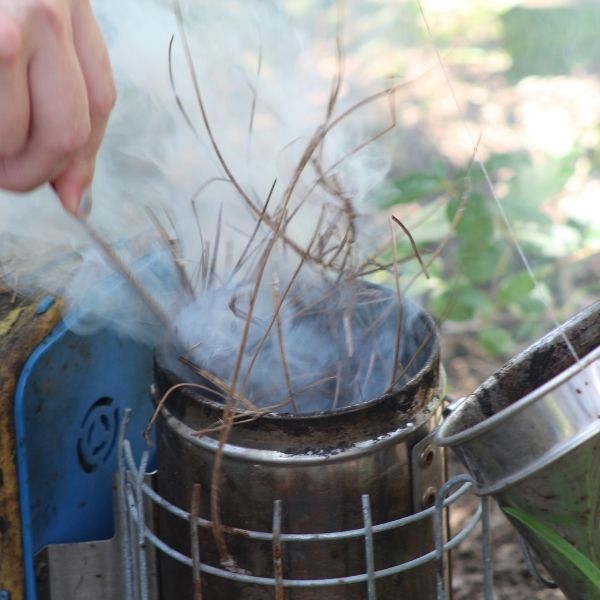
Pressing loose pinestraw into smoker
Pine Straw As Smoker Fuel
When using pine straw, start with a small amount of fuel in a loose bundle. Increase the amount of fuel and the tightness of the bundle as you add more to your smoker.
You want it loose at the bottom, where the embers are, and tight at the top, just before the smoke leaves the smoker. Doing this ensures the embers build up nicely at the bottom. Then the smoke has to sift through the tight pine straw on its way up and out of the smoker.
This helps the smoke stay cool. The fuel burns up slowly as you continue to use the smoker. What happens is that the tight bundle at the top falls down to where the embers are, keeping your smoker lit. This is the general technique that needs practice so you can be sure the smoker lights well and stays lit without burning through the fuel too quickly.
This method applies to all types of loose fuel like cotton, burlap, wood chips, pine cones, etc.
You will add about 4 bundles of pine straw to fill up a standard smoker where the chamber is about 8 or 9-inches tall. If you are using one of the pro-style or large smokers, you will add about 5-6 bundles to fill up the smoker.
The only advantage of the taller smoker is that you can put more fuel in the smoker. It will also produce smoke longer.
Loading the smoker with 4 or 5 tight balls of pinestraw will be difficult to light and will smother the flame. Loading the smoker with too loose balls of pinestraw will burn too hot and the smoker will burn through it's fuel too quickly.
The trick is to use a combination of loose balls and tight balls of pine straw so the smoker lights easily, but burns slowly.

Pressing loose pinestraw into smoker
Pine Straw As Smoker Fuel
When using pine straw, start with a small amount of fuel in a loose bundle. Increase the amount of fuel and the tightness of the bundle as you add more to your smoker.
You want it loose at the bottom, where the embers are, and tight at the top, just before the smoke leaves the smoker. Doing this ensures the embers build up nicely at the bottom. Then the smoke has to sift through the tight pine straw on its way up and out of the smoker.
This helps the smoke stay cool. The fuel burns up slowly as you continue to use the smoker. What happens is that the tight bundle at the top falls down to where the embers are, keeping your smoker lit. This is the general technique that needs practice so you can be sure the smoker lights well and stays lit without burning through the fuel too quickly.
This method applies to all types of loose fuel like cotton, burlap, wood chips, pine cones, etc.
You will add about 4 bundles of pine straw to fill up a standard smoker where the chamber is about 8 or 9-inches tall. If you are using one of the pro-style or large smokers, you will add about 5-6 bundles to fill up the smoker.
The only advantage of the taller smoker is that you can put more fuel in the smoker. It will also produce smoke longer.
Loading the smoker with 4 or 5 tight balls of pinestraw will be difficult to light and will smother the flame. Loading the smoker with too loose balls of pinestraw will burn too hot and the smoker will burn through it's fuel too quickly.
The trick is to use a combination of loose balls and tight balls of pine straw so the smoker lights easily, but burns slowly.
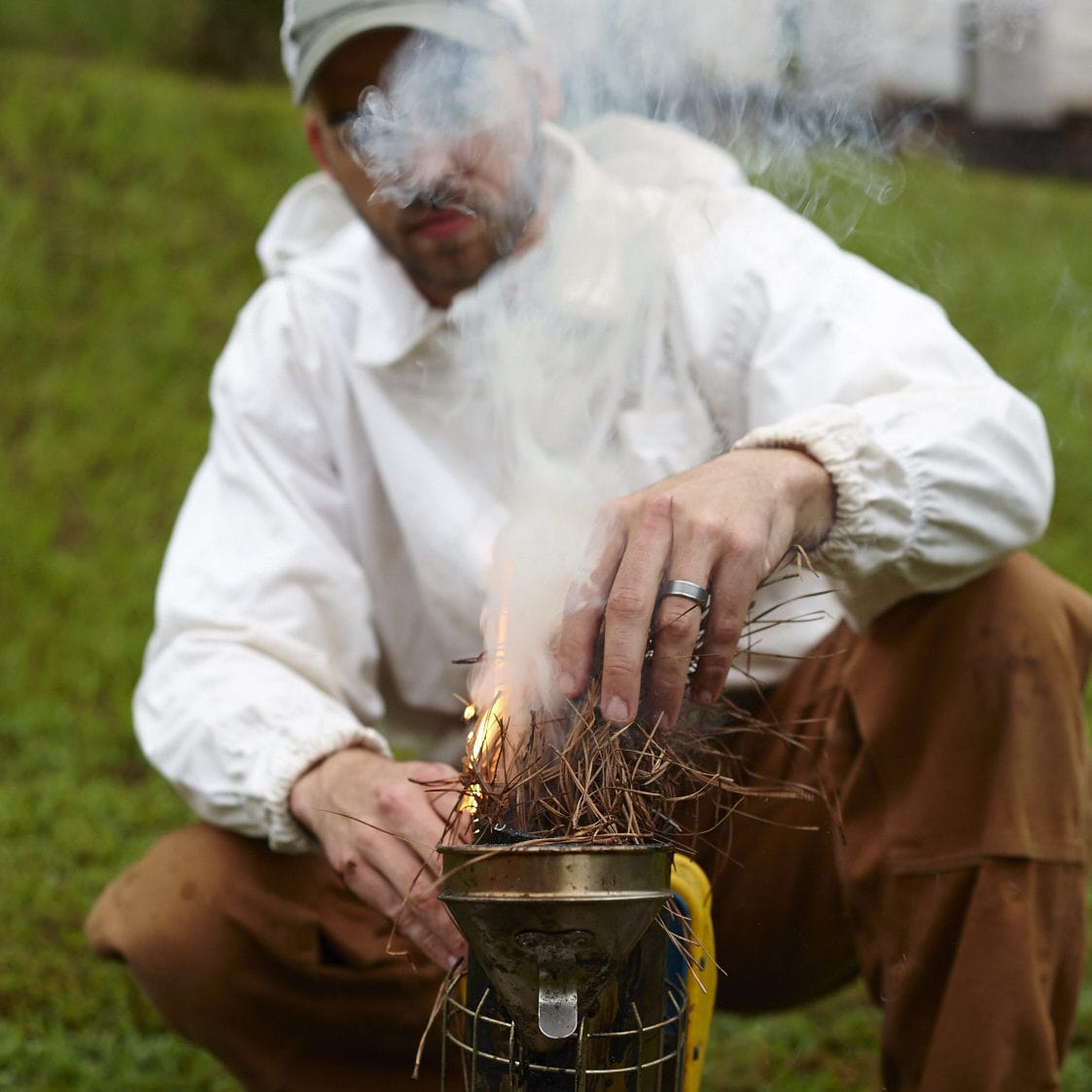
Lighting Pine Straw
Start by lighting the small, loose bundle of pine straw while holding it in your gloved hand. Once lit, drop it into the smoker and pump the bellow multiple times to keep the pine straw on fire. Like flames need to shoot up and out of the top of the smoker. Trust us.
Add your second, slightly larger, and slightly tighter bundle to the flames. Press the straw gently towards the bottom of the smoker with your hive tool.
Again, keep pumping the bellows until the straw flames up. Continue adding larger and tighter bundles to the smoker as you continuously pump the bellows. About 4-7 bundles total, depending on the size of your smoker. You want to fill that joker up.
Wait until flames or intensely thick smoke coming from the smoker before adding the next bundle. Once you put the top on, the very hot fire on the smoker’s bottom will smolder a little, but keep the pine straw lit.
The #1 mistake I see beginner beekeepers make is they fill the smoker up with fuel and light it. Don't do this. You'll light the top of the fuel and it will smoke well, but the smoker burns out quickly. The fire doesn't sift down the smoker. Build your fire at the bottom of the smoker, not the top.
Also, doing this will blow hot smoke and embers onto your bees. They do not like that.

Lighting Pine Straw
Start by lighting the small, loose bundle of pine straw while holding it in your gloved hand. Once lit, drop it into the smoker and pump the bellow multiple times to keep the pine straw on fire. Like flames need to shoot up and out of the top of the smoker. Trust us.
Add your second, slightly larger, and slightly tighter bundle to the flames. Press the straw gently towards the bottom of the smoker with your hive tool.
Again, keep pumping the bellows until the straw flames up. Continue adding larger and tighter bundles to the smoker as you continuously pump the bellows. About 4-7 bundles total, depending on the size of your smoker. You want to fill that joker up.
Wait until flames or intensely thick smoke coming from the smoker before adding the next bundle. Once you put the top on, the very hot fire on the smoker’s bottom will smolder a little, but keep the pine straw lit.
The #1 mistake I see beginner beekeepers make is they fill the smoker up with fuel and light it. Don't do this. You'll light the top of the fuel and it will smoke well, but the smoker burns out quickly. The fire doesn't sift down the smoker. Build your fire at the bottom of the smoker, not the top.
Also, doing this will blow hot smoke and embers onto your bees. They do not like that.
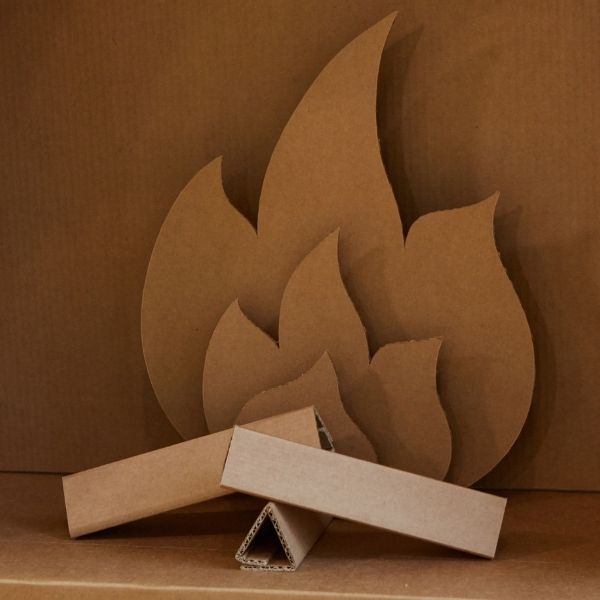
Cardboard As Smoker Fuel
Cardboard is a great backup fuel source for your smoker. It could even be your main fuel if you want it to. It is slightly harder to light then pine straw but will produce smoke for a long time if you use the cardboard right. The trick is to roll it up tightly.
In using cardboard, form it into a tight roll with the corrugated tunnels running vertically in the smoker. It is important they run vertically so there is plenty of airflows from the bottom to the top of the smoker.
Using cardboard works really well at produces a thick, cool smoke so this technique is something you should definitely have in your back pocket. I know beekeepers who will roll a half-dozen of these and tape each one into a tight roll. That way they are ready to go.
When rolling them, it works best to roll them into the diameter of the inside of your smoker. Not too tight that you have to pound it into the smoker, but not so loose that it moves back in forth in the chamber a lot.

Cardboard As Smoker Fuel
Cardboard is a great backup fuel source for your smoker. It could even be your main fuel if you want it to. It is slightly harder to light then pine straw but will produce smoke for a long time if you use the cardboard right. The trick is to roll it up tightly.
In using cardboard, form it into a tight roll with the corrugated tunnels running vertically in the smoker. It is important they run vertically so there is plenty of airflows from the bottom to the top of the smoker.
Using cardboard works really well at produces a thick, cool smoke so this technique is something you should definitely have in your back pocket. I know beekeepers who will roll a half-dozen of these and tape each one into a tight roll. That way they are ready to go.
When rolling them, it works best to roll them into the diameter of the inside of your smoker. Not too tight that you have to pound it into the smoker, but not so loose that it moves back in forth in the chamber a lot.
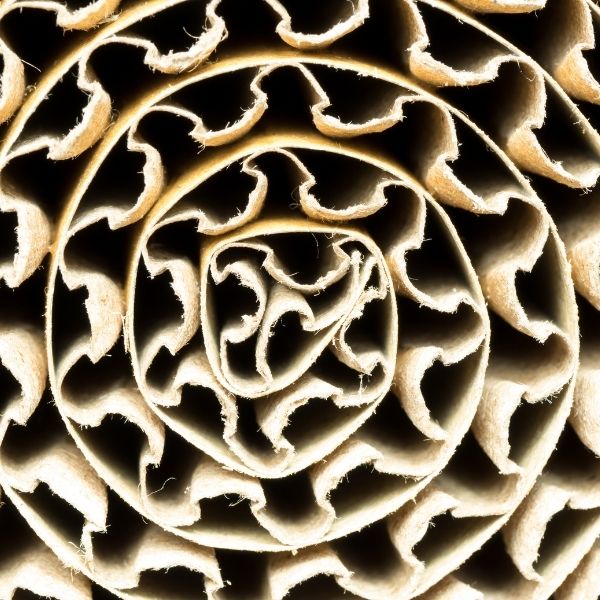
Cardboard flutes in the right direction.
Light Cardboard For A Bee SMoker
Start cutting a strip of cardboard ¾ the height of your smoking chamber, 5-inches for a regular smoker and 7-inches for a pro smoker. You want the finished cardboard roll to be about ¾ of it so there is room for airflow on the bottom of the smoker and so the lid closes.
You want the cardboard to form a tight roll that fills the smoker. If you have the “flutes” verticle tunnels running from the bottom of the smoker to the top, you can’t roll it too tight. The tighter you roll it, the longer the smoker will work. Starting with the short end, roll the cardboard tightly into a big cigar-type shape. Hold it closed with a piece of tape. It helps to make these before going out to the bee yard.
If you roll up the cardboard and find that the diameter is not wide enough, you can just cut another strip of cardboard and roll it around the small one.
When using other piecey types of fuel like pine straw or wood chips, you would add a little fuel at a time to build a fire up. You can’t really do that with cardboard. When using cardboard, you would like the bottom of the tube while holding it, and once well-lit, it is pushed into the smoker. A few puffs from the bellow and the cardboard will be lit and working well.

Cardboard flutes in the right direction.
Light Cardboard For A Bee SMoker
Start cutting a strip of cardboard ¾ the height of your smoking chamber, 5-inches for a regular smoker and 7-inches for a pro smoker. You want the finished cardboard roll to be about ¾ of it so there is room for airflow on the bottom of the smoker and so the lid closes.
You want the cardboard to form a tight roll that fills the smoker. If you have the “flutes” verticle tunnels running from the bottom of the smoker to the top, you can’t roll it too tight. The tighter you roll it, the longer the smoker will work. Starting with the short end, roll the cardboard tightly into a big cigar-type shape. Hold it closed with a piece of tape. It helps to make these before going out to the bee yard.
If you roll up the cardboard and find that the diameter is not wide enough, you can just cut another strip of cardboard and roll it around the small one.
When using other piecey types of fuel like pine straw or wood chips, you would add a little fuel at a time to build a fire up. You can’t really do that with cardboard. When using cardboard, you would like the bottom of the tube while holding it, and once well-lit, it is pushed into the smoker. A few puffs from the bellow and the cardboard will be lit and working well.

Cardboard flutes in the right direction.
Pro Tips For Lighting A Beekeepers Smoker
- Pack it full of pine straw or another type of loose fuel. Just doing that helps to keep the smoker from burning too hot.
- Use a wad of green grass or other vegetation on the very top of the fuel before closing the top, this gives the smoke one last chance to cool down before leaving. You don’t want hot smoke.
- Throw something else in the smoker while building it to extend the smoke time. We regularly add dried pinecones to the smoker along with the pine straw.
- Don’t forget that the smoker needs air, pump the bellow periodically to keep the embers in the smoker lit.
- Dump the fuel out when done and stomp it out or pour water on it.
- Get the first bundle of pine straw on FIRE before adding the next.
- Don’t buy a cheap, undersized smoker like this one. While they look the same, they are too small to be functional. They are meant to be cheap and to trick the beginner beekeeper into buying them.

Cardboard flutes in the right direction.
Pro Tips For Lighting A Beekeepers Smoker
- Pack it full of pine straw or another type of loose fuel. Just doing that helps to keep the smoker from burning too hot.
- Use a wad of green grass or other vegetation on the very top of the fuel before closing the top, this gives the smoke one last chance to cool down before leaving. You don’t want hot smoke.
- Throw something else in the smoker while building it to extend the smoke time. We regularly add dried pinecones to the smoker along with the pine straw.
- Don’t forget that the smoker needs air, pump the bellow periodically to keep the embers in the smoker lit.
- Dump the fuel out when done and stomp it out or pour water on it.
- Get the first bundle of pine straw on FIRE before adding the next.
- Don’t buy a cheap, undersized smoker like this one. While they look the same, they are too small to be functional. They are meant to be cheap and to trick the beginner beekeeper into buying them.




